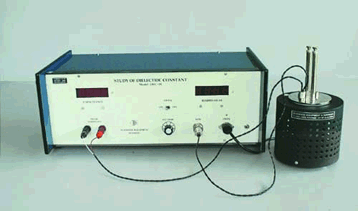Description of the experimental set-up
Probes Arrangement
It has two individually spring loaded probes. The probes arrangement is mounted in a suitable stand, which also holds the sample plate. To ensure the correct measurement of sample temperature, the RTD is embedded in the sample plate just below the sample. This stand also serves as the lid of temperature controlled oven. Proper leads are provided for connection to Capacitance Meter and Temperature Controller.
Sample
Barium Titanate (BaTiO3)
Oven
This is a high quality temperature controlled oven. The oven has been designed for fast heating and cooling rates, which enhances the effectiveness of the controller.
Main Units
The Set-up consists of two units housed in the same cabinet.
a)Oven Controller
Platinum RTD (A class) has been used for sensing the temperature. A Wheatstone bridge and an instrumentation amplifier are used for signal conditioning. Feedback circuit ensures offset and linearity trimming and a fast accurate control of the oven temperature.
Specifications of the Oven
Temperature Range
|
Ambient to 473K |
Resolution
|
1K |
Stability
|
0.5K |
Measurement Accuracy
|
1K (typical) |
Oven
|
Specially designed for Dielectric measurement |
Sensor
|
RTD (A class) |
Display
|
3½ digit, 7 segment LED with autopolarity and decimal indication |
Power
|
150W |
|


